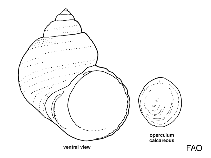|
Family Turbinidae - Turban shells
|
Order |
: |
|||
Class |
: |
Gastropoda |
||
No. of Genera in Ref. |
: |
|||
No. of Species in Ref. |
: |
|||
Environment |
: |
Fresh : No |
Brackish : No |
Marine : Yes |
||
Aquarium |
: |
|||
First Fossil Record |
: |
|||
Remark |
: |
Shell thick, often heavy, turbinate to conical (occasionally flattened) in shape. Outer sculpture very variable, often spiral to nodular. Periostracum well developed to absent. Aperture variously rounded, without a siphonal canal, nacreous inside. Inner lip smooth. Umbilicus present, at least at juvenile stages. Operculum strongly calcified externally, its inner layer corneour, usually showing spiral coiling with a subterminal or central nucleus. Head with a short, mid-ventrally split anout, and a pair of long tentacles, the eyes on stalks at their outer bases. Foot large and ovate, sometimes anteriorly truncate, with a fleshy ridge on either side bearing tentaculate processes. Mainly living in shallow waters of warm temperate and tropical seas, especially on rocky and coral reef habitats. Herbivorous animals, feeding on small epibenthic algae and vegetable detritus. Sexes separate, fertilization external. Eggs generally released in gelatinous masses, hatching as free-swimming planktonic larvae. Turbans (especially the larger species) are commonly collected in the Indo-West Pacific, both for their edible flesh and nacreous shell. They are locally valued for food and some are sought for mother-of-pearl or for carving ornaments. In recent years, heavy commercial exploitations have locally depleted populations. Efforts are expected in the future to produce juveniles in hatcheries and introduce turbans in areas in which they have become extinct or areas currently poor in fisheries resources (Ref. 349). |
||
Etymology |
: |
|||
Division |
: |
|||
Reproductive guild |
: |
|||
Typical activity level |
: |
|||
Main Ref. |
: |
|||
Coordinator |
: |
|||
